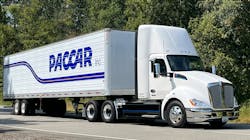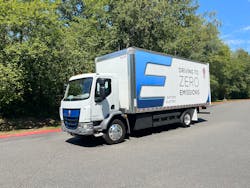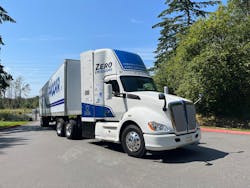Kenworth is doubling down on electric vehicle (EV) investment by betting on both battery-electric and hydrogen technologies, with executives saying widespread adoption is inevitable as regulatory requirements and economic benefits coincide. Speaking at a press event at Paccar headquarters in Bellevue, Washington, Kenworth executives outlined the company's assessment of the current and future EV market.
“I think it's a technology that is too interesting to ignore,” said Stephan Olsen, Kenworth’s general sales manager of fleet and specialty markets. “From a regulatory standpoint, all arrows are pointing toward zero emissions.”Regulatory and economic change
Seventeen U.S. states and Canada have signed on to a memorandum of understanding, setting a target for 30% of Class 7-8 tractor registrations to be zero-emission vehicles (ZEVs) by 2030 and all commercial vehicles being ZEVs by 2040. The U.S. government’s current climate policy sets the benchmark of achieving net-zero emissions by 2050.
See also: Paccar TX-18, TX-18 Pro automated transmissions available
Kenworth predicts industry EV production in the U.S. and Canada will ramp up exponentially in the coming years, from just under 40,000 electric trucks by 2028 to around 70,000 by 2030, then more than 160,000 by 2040.
“In the 2030s and 2040s, we're in real volumes, tens of thousands,” Olsen said, “and this is where we will begin to see the economies of scale helping out with the costs, with the infrastructure development.”
In addition to the advantages brought by economies of scale, Jamin Swazo, director of marketing communications, said that EVs will offer fleets additional savings. With zero-emission vehicles, fleets can see upwards of 50% reduction in energy costs. Also, with fewer moving parts and no need for diesel exhaust aftertreatment, maintenance costs have the chance to be up to 30% less.
Increased interest, changing norms
See also: Paccar pricing power drives Q2 results to new levels
Andy Zehnder, director of fleet sales, advanced technologies, and specialty accounts, said, “I think today we operate in silos. And as we look to the future, those that are successful are going to be the ones that have those partnerships."
When building and maintaining charging infrastructure, Paccar partners with Schneider Electric and EnTech Solutions.
“Now there are a lot of fleets bringing their charging ‘behind the fence,’ so they actually become an energy provider themselves,” said Alec Cervenka, EV grant and technical advisor.
Joe Adams, chief engineer, said fleets want to control their energy costs. Even further, companies developing microgrids can sell electricity back into the grid as an additional revenue stream.
Swazo added that Kenworth has heard from customers who, even if it's not a goal to run sustainable businesses, they want to use zero-emission trucks because they want to meet the initiatives of customers with sustainability goals.
Andy Zehnder said Kenworth has seen interest in EVs outside of sectors most would expect.
“We have customers that are coming to us, that are in industries that you would not consider to be interested in green or sustainability initiatives such as the petroleum industry. Why would a petroleum industry customer want an electric truck?” Zehnder said. “As it turns out, they have an image that they're trying to change from being dirty diesel to the future of fuel. And in this particular instance, it was that they are interested in hydrogen and battery-electric trucks. Pulling their diesel today could transition them to a hydrogen truck with hydrogen in the future. Battery-electric is just one step from hydrogen. You're just taking a fuel cell and replacing the energy storage of the battery.”
Olsen said there's no silver bullet, no "technology we know today that's going to serve all those customers and meet their expectations for range, refueling or recharging time, and then the payload capacity as well. And that's why Kenworth is investing in both technologies,” battery electric, and hydrogen fuel cell.
About the Author
Scott Keith
Scott Keith is a former fleet owner digital editor, who was on staff from 2022 to 2023.



